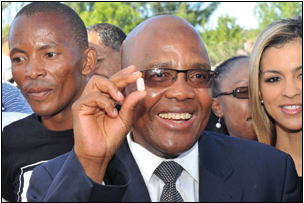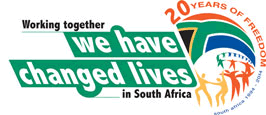Steady doses of government intervention over the past 20 years have put South Africa’s health care system on a steady road to recovery, with citizens now enjoying longer, healthier lives.
 HIV infections have decreased, life expectancy increased, anti-retrovirals (ARVs) are freely available, and the National Health Insurance (NHI) promises greater access to health care for those who need it the most.
HIV infections have decreased, life expectancy increased, anti-retrovirals (ARVs) are freely available, and the National Health Insurance (NHI) promises greater access to health care for those who need it the most.
Over these past two decades, the national Department of Health has been hard at work, introducing and prioritising a number of initiatives to achieve these successes.
The department targeted four key areas to improve the health system, which included increasing life expectancy; decreasing maternal and child mortality; combating HIV and AIDS and decreasing the burden of disease from TB; and strengthening the effectiveness of the health system.
HIV and Aids
In 2009 President Jacob Zuma gave the country’s HIV and AIDS policies a facelift.
The President announced that all children under one year of age would get treatment if they tested positive and that treatment would not depend on the CD4 count.
All patients with both TB and HIV would get ARV treatment if their CD4 count was 350 or less.
In addition, pregnant HIV positive women with a CD4 count of 350 or with symptoms regardless of CD4 count would have access to treatment.
Previously HIV positive pregnant women were eligible for treatment if their CD4 count was less than 200.
All other pregnant women who did not fall into this category were to be put on treatment at 14 weeks of pregnancy to protect their babies. In the past this only started during the last term of pregnancy.
All these policies were to be effective from April 2010.
Also in 2009, the department announced the HIV Counselling and Testing (HCT) Campaign, which was to be the cornerstone for the prevention and early entry into ARVs.
According to the department by 2012, 1.6 million people were receiving ARVs and 20.2 million people had tested for HIV.
As part of the HCT campaign, government also introduced the male circumcision campaign and in 2012 alone, 619 000 males were circumcised.
According to the Department of Health’s 2012 Mid Term Review Report, the rate at which TB was being cured rose to 73 per cent.
This achievement has resulted from a combination of interventions, such as using the new Genexpert technology, which was introduced in 2011.
From March 2011 to February 2012, South Africa had conducted almost 300 000 Genexpert tests to detect the disease.
The report also notes the progress in reducing new HIV infections with the mother-to-child transmission rate dropping from 3.5 per cent in 2010 to less than two per cent in 2012.
In another development with regards to HIV and AIDS, Health Minister Aaron Motsoaledi officially launched the Fixed Dose Combination drug in April this year. With the new pill, patients take one tablet once a day instead of three to five.
Meanwhile, the South African National Aids Council (SANAC), recently announced that the country was making progress in the Millennium Development Goal set by the United Nations of reducing HIV infections by half by 2015.
South Africa’s Anti-Retroviral Treatment Programme now reaches more than two million people, making it the largest HIV treatment programme in the world.
In addition, Deputy President Kgalema Motlanthe announced at the 6th Aids Conference recently that the number of HIV-related deaths reported had decreased from 613 108 in 2006 to 543 856 in 2010.
Most researchers, as well as Statistics South Africa (Stats SA), have attributed this decline to the distribution and use of condoms as well as the ARV programme.
South Africans are also enjoying longer lives, according to statistics.
Stats SA’s 2013 mid-year population estimates shows that life expectancy increased from 52 years in 2004 to 58 years in 2011 and is estimated to have increased further, to just under 60 years (or 59.4 years) in the 2013 estimates – with life expectancy of women at 61 years and men at 58.
Government can also channel more money to the country’s HIV and TB programmes after getting R3 billion from the Global Fund to support these.
The fund will provide support in:
- ARV treatment for 350 000 patients.
- HIV testing for more than a million people, including people living in rural areas and on farms.
- Full screening for TB of all inmates at 258 correctional services facilities.
- Screening for more than 400 000 miners and communities around mines.
- Prevention and referral services for 33 000 sex workers in all nine provinces.
- Prevention and referral services for 150 000 men who have sex with men.
- Care and support for more than 40 000 orphans.
- Medical male circumcision for 94 500 men.
National Health Insurance
South Africa is also making significant progress with the NHI - a financing system that will make sure all South Africans get essential health care, regardless of how much they earn.
In March last year, Minister Motsoaledi announced the 10 districts where the NHI would be piloted.
These included Dr K. Kaunda in the North West Province, Pixley ka Seme in Northern Cape, Thabo Mofutsanyane in the Free State, Eden in Western Cape, OR Tambo in Eastern Cape, Gert Sibande in Mpumalanga, Vhembe in Limpopo, Umzinyathi and Umgungundlovu in KZN and Tshwane District in Gauteng.
The department has been auditing health facilities to evaluate health infrastructure and to determine what would be needed for the NHI.
By April this year 3 880 public health facilities were audited. This covers all clinics, health centres and district, regional, specialised and tertiary hospital in all nine provinces.
The department has appointed 102 hospital managers as part of the NHI and about 500 private doctors to start providing services in the NHI pilots in under-served areas.
Primary health care
Primary health care (PHC) has also been high on the department’s agenda.
Some of the focus areas of PHC are the building of clinics and hospitals, managing diseases and making sure there are enough health professionals.
Minister Motsoaledi has also turned his attention to primary care with three key remedies: district specialists, school based health programme and municipal ward-based PHC agents.
District specialists include a principal obstetrician, principal paediatrician, principal family physician, advanced midwife and senior primary care nurse.
These specialists train interns, community service doctors and medical officers. They are the link between the prevention and management and cure of diseases.
As of November 2012, 163 district specialists were appointed to the 46 districts in the country.
With regards to the school-based health care programme, school health teams visited 1 610 poor schools between July and September 2012. They took care of eye-care , dental and hearing problems, as well as immunisation at schools.
As part of efforts to improve primary care, 10 000 primary health care workers were trained and assigned to municipal wards in the country.
In each ward there is a team comprising a professional nurse and six community health care workers.
With all these initiatives the health care services offered to South Africans has significantly improved over the years and can only get better in the years ahead.
 Between 1994 and 2004, over 1 200 new clinics were built.
Between 1994 and 2004, over 1 200 new clinics were built.- Patient satisfaction increased from 54 per cent in 2009 to 61.9 per cent in 2011.
- The infant mortality rate decreased from 40 deaths per 1 000 live births in 2009 to 30 deaths per live births in 2011.
- The under-5 mortality rate decreased from 56 deaths per 1 000 live births in 2009 to 42 deaths per 1 000 live births in 2011.
- The TB cure rate improved from 63.4 per cent in 2009 to 73.8 per cent in 2012/13.



 Facebook
Facebook Twitter
Twitter WhatsApp
WhatsApp